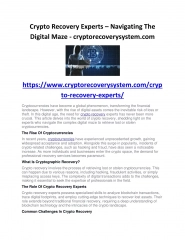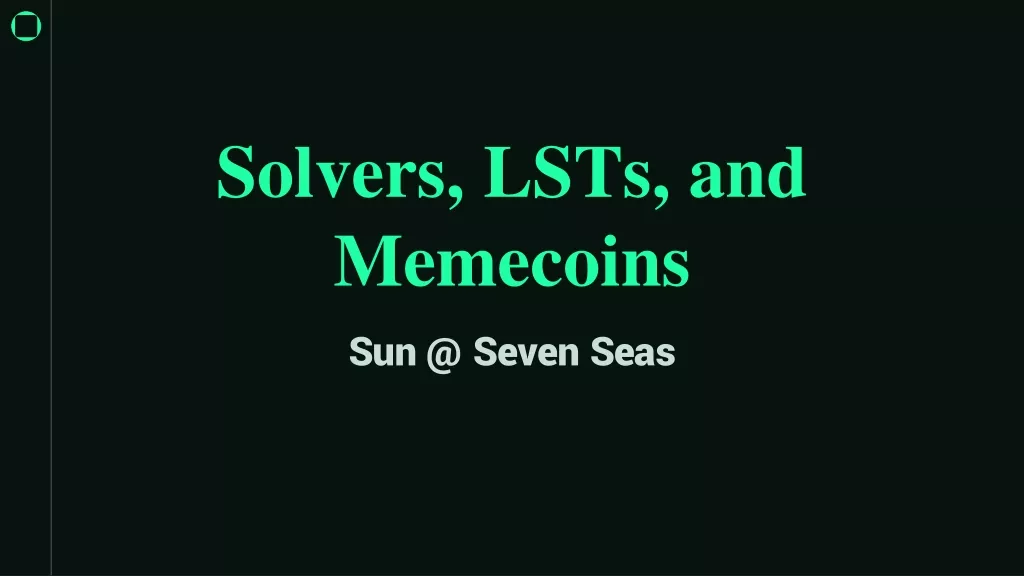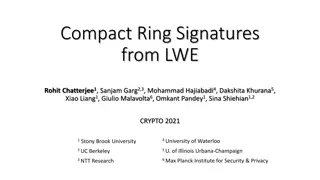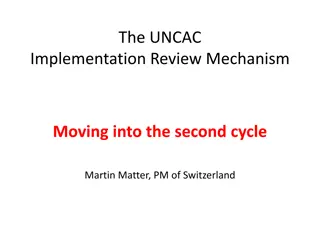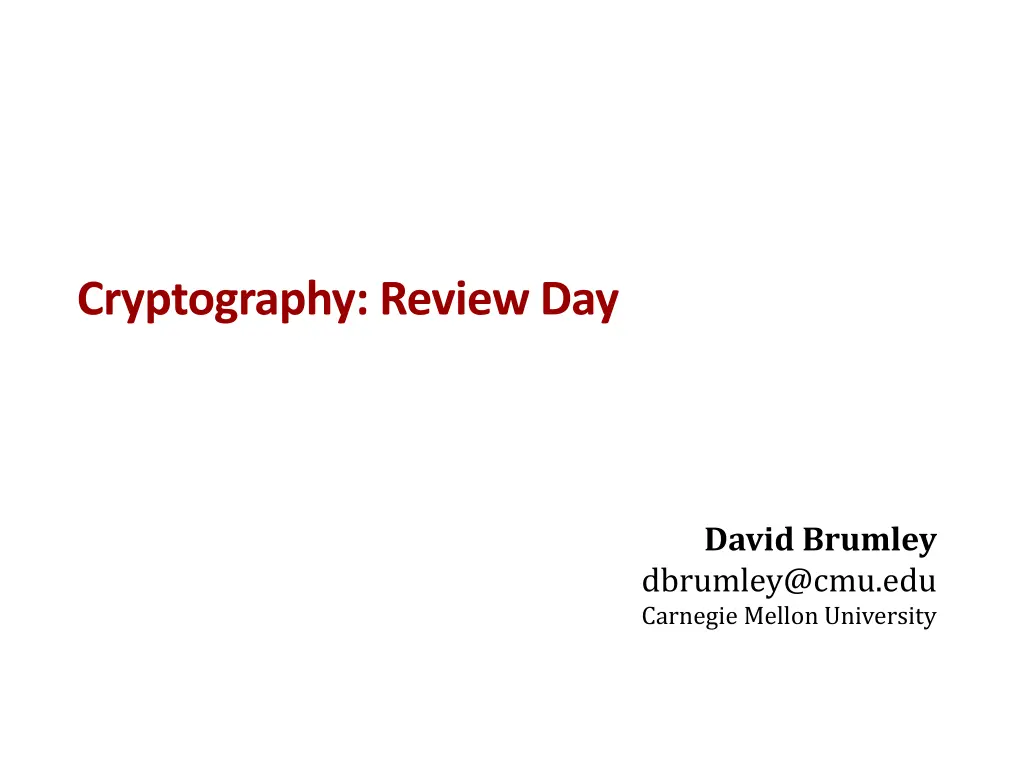
Cryptography Review Day: Ensuring Privacy, Integrity, and Authenticity
Discover the fundamentals of cryptography, from perfect secrecy to block ciphers and meet-in-the-middle attacks. Explore concepts like the one-time pad, PRNGs, and modes of operation for block ciphers. Learn about semantic security and the importance of choosing secure encryption modes. Dive into the world of cryptography with insights from Carnegie Mellon University's David Brumley.
Download Presentation

Please find below an Image/Link to download the presentation.
The content on the website is provided AS IS for your information and personal use only. It may not be sold, licensed, or shared on other websites without obtaining consent from the author. If you encounter any issues during the download, it is possible that the publisher has removed the file from their server.
You are allowed to download the files provided on this website for personal or commercial use, subject to the condition that they are used lawfully. All files are the property of their respective owners.
The content on the website is provided AS IS for your information and personal use only. It may not be sold, licensed, or shared on other websites without obtaining consent from the author.
E N D
Presentation Transcript
Cryptography: Review Day David Brumley dbrumley@cmu.edu Carnegie Mellon University
m or error m Public Channel c c D Bob Alice E ke ke Eve read/write access Cryptonium Pipe Goals: Privacy, Integrity, and Authenticity 2
Perfect Secrecy [Shannon1945] (Information Theoretic Secrecy) Defn Perfect Secrecy (informal): We re no better off determining the plaintext when given the ciphertext. Alice Bob 1. Eve observes everything but the c. Guesses m1 2. Eve observes c. Guesses m2 Goal: Eve 5
The One Time Pad Miller, 1882 and Vernam, 1917 M = C = K = {0,1}n m: k: 0 1 1 1 1 0 0 1 1 0 1 0 0 0 c: 1 0 1 1 1 1 0 k: m: 1 0 1 1 0 1 1 0 0 1 0 1 0 0 6
PRNGs, Stream Cipher PRNG(k): Amplify a small amount of randomness k. Stream Cipher: PRNG(k) xor M 7
Block Ciphers Modes of operations CBC, CTR, etc. What modes do for security, e.g., why ECB is bad, why randomize an IV for CBC, etc. Definitions Is a block cipher a PRP or PRF Attacks 8
Exhaustive Search for block cipher key Goal: given a few input output pairs (mi, ci = E(k, mi)) i=1,..,n find key k. Attack: Brute force to find the key k. Homework: What is the probability that the key k found with one <m,c> pair is correct? For two pairs? 9
Meet in the middle attack Define 2E( (k1,k2), m) = E(k1 , E(k2 , m) ) key-len = 112 bits for 2DES E(k2, ) E(k1, ) c m m c' c c Idea: key found when c = c : E(ki, m) = D(kj, c) 10
Semantic security under CPA Modes that return the same ciphertext (e.g., ECB, CTR) for the same plaintext are not semantically secure under a chosen plaintext attack (CPA) (many-time-key) m0, m0 M C0 E(k,m) m0, m1 M Cb E(k,mb) Challenger Adversary A k K if cb = c0 output 0 else output 1 11
Semantic security under CPA Modes that return the same ciphertext (e.g., ECB, CTR) for the same plaintext are not semantically secure under a chosen plaintext attack (CPA) (many-time-key) m0, m0 M C0 E(k,m) m0, m1 M Cb E(k,mb) Challenger Adversary A k K if cb = c0 output 0 else output 1 Encryption modes must be randomized or use a nonce (or are vulnerable to CPA) 12
Message Integrity Goal: integrity (not secrecy) Examples: Protecting binaries on disk. Protecting banner ads on web pages Security Principles: Integrity means no one can forge a signature 14
Secure PRF: An Alternate Interpretation For b = 0,1 define experiment EXP(b) as: Challenger F b Adversary b Def: PRF is a secure PRF if for all efficient A, A does no better than guessing for b . 15
Secure MAC Game Challenger Adversary A 1. k = KeyGen(l) m1,...,mq 2. Picks m1, ..., mq 3. Compute i in 0...q: ti = S(mi, k) t1,...,tq m,t 4. picks m not in m1,...,mq Generates t 5. b = V(m,t,k) existential forgery if b= yes b = {yes,no} Security goal: A cannot produce a valid tag on a message Even if the message is gibberish 16
Birthday Paradox Rule of Thumb Given N possibilities, and random samples x1, ..., xj, PR[xi = xj] 50% when j = N1/2 17
One-way and Collision Resistance f is one-way if there is no computationally efficient Adversary given f(x) =y that can find a x such that f(x ) = y f is collision resistant if it is difficult to find two inputs x and x such that f(x) = f(x ) These are different concepts! (Think of a collision resistant function that is not one way) 18
Generic attack on hash functions Let H: M {0,1}n be a hash function ( |M| >> 2n ) Generic alg. to find a collision in time O(2n/2) hashes Algorithm: 1. Choose 2n/2random messages in M: m1, , m2n/2 (distinct w.h.p ) 2. For i = 1, , 2n/2 compute ti = H(mi) {0,1}n 3. Look for a collision (ti = tj). If not found, got back to step 1. How well will this work? 19
Brute Force Online Brute Force Attack: input: hp = hash(password) to crack for each i in dictionary file if(h(i) == hp) output success; Time Space Tradeoff Attack: precompute: h(i) for each i in dict file in hash tbl input: hp = hash(password) check if hp is in hash tbl rainbow tables 20
Salts Enrollment: 1. 2. compute hp=h(password + salt) store salt || hp Verification: 1. 2. Look up salt in password file Check h(input||salt) == hp What is this good for security, given that the salt is public? Salt doesn t increase security against online attack, but does make tables much bigger. 21
Motivating Question: Which is Best? Encryption Key = KE; MAC key = kI Option 1: SSL (MAC-then-encrypt) E(kE , m||tag) m S(kI, m) tag m m tag Option 2: IPsec (Encrypt-then-MAC) E(kE, m) m S(kI , c) tag m m Option 3: SSH (Encrypt-and-MAC) E(kE, m) m S(kI , m) tag m m 23
An authenticated encryptionsystem (E,D) is a cipher where As usual: E: K M N C but D: K C N M { } reject ciphertext as invalid Security: the system must provide Semantic security under CPA attack, and ciphertext integrity. The attacker cannot create a new ciphertext that decrypts properly. 24
CCA Game Definition Let ENC = (E,D) over (K,M,C). For b = {0,1} randomly chosen for i=1, ,q: (1) CPA query: Chal. k K Adv. b mi,0 , mi,1 M : |mi,0| = |mi,1| Ex: could query a changed ci ci E(k, mi,b) (2) CCA query: ci C : ci {c1, , ci-1} b {0,1} mi D(k, ci) 25
1. Pick a from [0,p-1) 2. Pick b from [0,p-1) 3. ga mod p Bob Alice 4. gb mod p 5. Compute (ga)b mod p as secret key 6. Compute (gb)a mod p as secret key Eve Eve observes: g, ga, gb Goal: compute a (or b) (i.e., calculate the discrete log) or compute gab 27
MITM Adversary As described, Diffie-Hellman is insecure against active Man In The Middle (MITM) attacks Alice MITM Bob ga mod p gm mod p gm mod p gb mod p gmb mod p gma mod p 28
Easy and Hard Problems Factoring Discrete Log Exponentiation 29
Questions? 30
Questions? 31
Thought 33
Public Key Encryption Def: a public-key encryption system is a triple of algorithms (G, E, D) G(): randomized alg. outputs a key pair (pk, sk) E(pk, m): randomized alg. that takes m M and outputs c C D(sk,c): determisitic alg. that takes c C and outputs m M or Consistency: (pk, sk) output by G : m M: D(sk, E(pk, m) ) = m Note: Without randomization, an attacker can determine E(pk,m1) = E(pk,m2) when m1=m2 34
Semantic Security For b=0,1 define experiments EXP(b) (i.e., EXP(0) and EXP(1)): pk Chal. Adv. A b m0 , m1 M : |m0| = |m1| (pk,sk) G() c E(pk, mb) b {0,1} EXP(b) No query encryptions of messages. Why? Def: Enc =(G,E,D) is sem. secure (a.k.a IND-CPA) if for all efficient A: AdvSS [A,Enc] = |Pr[EXP(0)=1] Pr[EXP(1)=1] | < negligible 35

